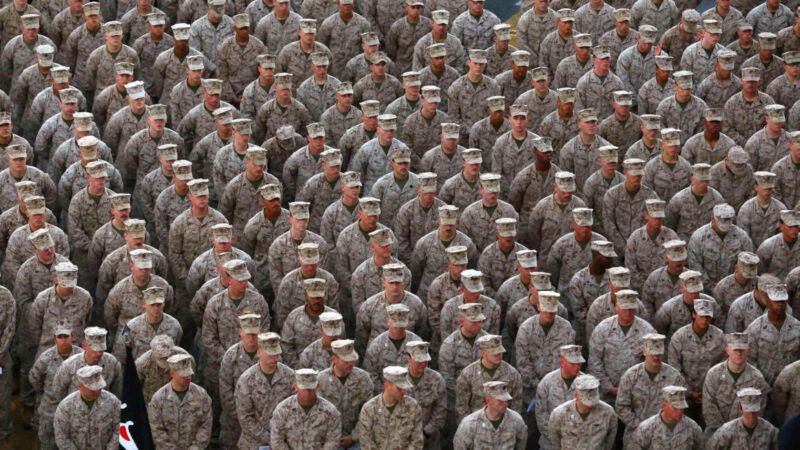On Memorial Day, Remember Skepticism Toward a Large, Standing Military
Thank the troops, but question the uses to which they’re put.

In recent years, it's become common to thank both retired and active-duty military personnel for their service – an expression met with various measures of appreciation or discomfort by recipients. The new custom is a step beyond the long-established sentiments embodied by Memorial Day, which acknowledges those who fell in combat in the ranks of a rare American institution that retains wide public confidence. While the thank-yous are well-intentioned, they represent a shift in attitude for a country that once distrusted anything resembling a powerful military. They also gloss over the costs—acknowledged on Memorial Day—of war and vast armed establishments. Those costs are worth emphasizing as the U.S. finally prepares to extract itself from a two-decade conflict in Afghanistan.
"A standing military force, with an overgrown Executive will not long be safe companions to liberty," James Madison, later to become fourth president of the United States, argued at the Constitutional Convention in 1787. "Throughout all Europe, the armies kept up under the pretext of defending, have enslaved the people."
The founders' antipathy to a large, permanent military establishment prevailed for over a century. "Americans had a distrust of a large standing army, going back to the founding of the republic," the Department of Defense notes as among the barriers to be overcome before the U.S. could effectively enter World War I.
But that barrier has long since eroded. As of 2020, the U.S. accounts for 39 percent of all money spent on the entire planet for military matters, according to the Stockholm International Peace Research Institute. Attitudes have changed, too, as you might expect from the proliferation of "thank you for your service" as a greeting.
"Western Europeans and Americans tend to trust their militaries much more than other national institutions," Pew Research reported in 2018 at a time when approval of the military stood at or above 80 percent in France, Italy, the United States, and the United Kingdom.
Last year, Gallup found U.S. public confidence in the military was exceeded only by confidence in small business.
Since then, the public has cooled a bit on the military, with a February 2021 poll by the Ronald Reagan Presidential Foundation and Institute finding a drop in trust from 70 percent in 2018 to 56 percent now. But that still far exceeds faith in any other institution, including all branches of government.
Americans, like Europeans, enjoy warm and fuzzy feelings toward the troops even as events seem designed to demonstrate the wisdom of James Madison's warnings about the danger posed by standing armies. In recent months, military officers in France and Spain penned open letters to their governments warning of dire consequences if officials continue to pursue policies opposed by those in uniform.
"Paris is once again full of rumblings about the political ambitions of the French military — 60 years after France's iconic leader Charles de Gaulle saw off a coup bid by disaffected generals, who were furious at his decision to withdraw from Algeria," Voice of America noted earlier this month.
Despite complaints by politicians about extremism in the ranks in the wake of the January 6 riot, there's little evidence that American military personnel harbor similar political ambitions. Instead, the risks posed by the U.S. military are to the lives of its personnel and to the people of the countries where it is sent to intervene in pursuit of often ill-considered policy goals.
That includes a grim tally for Afghanistan, from which the United States is finally withdrawing after a 20-year war. As of November 2019, Brown University's Costs of War project estimated direct war deaths at 2,298 for the U.S. military, 1,145 for allied troops, 3,814 for private contractors, 64,124 for local military and police, 43,074 for civilians, and 42,100 for opposition fighters. With other deaths included, the estimate for lives lost in the war comes in at 157,000.
It's expensive to kill that many people. The total cost to American taxpayers of the 20-year war is estimated at $2.261 trillion. "Note that this total does not include funds that the United States government is obligated to spend on lifetime care for American veterans of this war, nor does it include future interest payments on money borrowed to fund the war," adds the Costs of War project.
This enormous cost in lives and wealth appears to have been largely pointless.
"A confidential trove of government documents obtained by The Washington Post reveals that senior U.S. officials failed to tell the truth about the war in Afghanistan throughout the 18-year campaign, making rosy pronouncements they knew to be false and hiding unmistakable evidence the war had become unwinnable," the newspaper reported in December 2019.
That's just one war made possible by America's vast war machine. It doesn't count the cost of intervention in Iraq or elsewhere. It certainly doesn't include the potential perils of conflicts to come, including growing speculation over war with China and Russia, most likely sparked by defense alliances with countries such as Taiwan and Ukraine.
"What would happen if arguably the two most powerful countries in the world squared off in a war against one another?" The National Interest recently asked about a possible war between the U.S. and China. "Mass destruction."
That's not an argument for pacifism—but it is evidence for the value of restraint. The price of conflicts past, present, and future should constantly be on our minds, as should the warnings of James Madison and others about the pitfalls inherent in maintaining a large standing military.
So, if you're so inclined, thank military personnel for their service. And, certainly, take time on Memorial Day to remember those who gave their lives for their country. But be sure to ask questions about what those sacrifices are in the service of, and perhaps remember some of the skepticism toward a standing military that marked the early years of this country.
